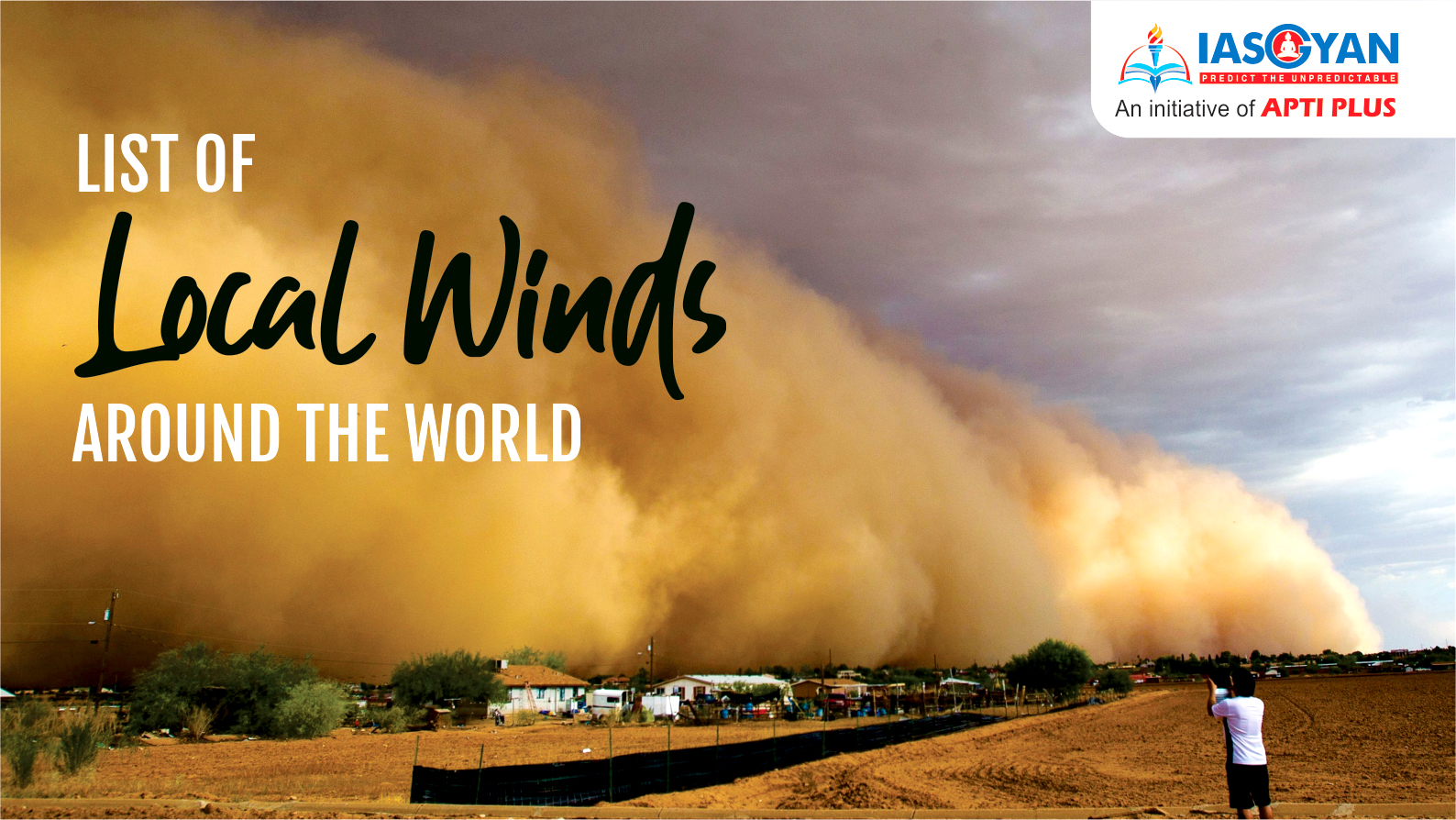




Austru: A east or southeast wind in Romania. They are cold in winter and may be a local name for a foehn wind.
Abroholos: A squall frequent from May through August between Cabo de Sao Tome and Cabo Frio on the coast of Brazil.
Alizé: Maritime wet, fresh northerly wind across west-central Africa and the Caribbean
Bora: north to the north-eastern katabatic wind in areas near the Adriatic Sea. Blows northeasterly from eastern Europe to northeastern Italy.
Bayamo: A violent wind blowing from the land on the south coast of Cuba, especially near the Bight of Bayamo.
Borasco: A thunderstorm or violent squall, especially in the Mediterranean.
Brickfielder: Hot and dry wind in Southern Australia that develops in the country's deserts in late spring and summer, which heavily raises temperatures in the coastal areas
Cape Doctor: dry south-easterly wind that blows on the South African coast in summer. It is known as the Cape Doctor because of a local belief that it clears Cape Town of pollution and 'pestilence'.
Chinook: warm, dry wind descending the eastern slopes of the Rocky Mountains in North America, primarily in winter
Chubasco: A violent squall with thunder and lightning, encountered during the rainy season along the west coast of Central America.
Coromell: A night land breeze prevailing from November to May at La Paz, near the southern extremity of the Gulf of California.
Diablo: hot, dry wind from the northeast that typically occurs in the San Francisco Bay Area of Northern California, during the spring and fall.
Etesian: blow northerly across Greece and Turkey. Etesian winds are a dominant weather influence in the Aegean Basin.
Elephanta: strong southerly or southeasterly wind which blows on the Malabar coast of India during the months of September and October and marks the onset of the southwest monsoon.
Foehn: A warm dry wind on the lee side of a mountain range, whose temperature is increased as the wind descends down the slope. It is created when air flows downhill from a high elevation, raising the temperature by adiabatic compression. Examples include the Chinook wind and the Santa Ana wind. Classified as a katabatic wind.
Fremantle Doctor: afternoon sea breeze from the Indian Ocean which cools Perth, Western Australia during summer. The sea breeze occurs because of the major temperature difference between the land and sea.
Gregale: A strong northeast wind of the central Mediterranean.
Harmattan: dry northerly wind across central Africa. Characterized by the dry and dusty northeasterly trade wind, of the same name, which blows from the Sahara Desert over West Africa into the Gulf of Guinea.
Haboob: A strong wind and sandstorm (or duststorm) in northern and central Sudan, especially around Khartum, where the average number is about 24 per year. The name come from the Arabic word, "habb", meaning wind.
Kali Andhi: the violent dust squalls that occur before the monsoon in the northwestern parts of the Indo-Gangetic Plain region of the Indian Subcontinent.
Karaburan: A violent northeast wind of Central Asia occurring during spring and summer. It resembles the white buran of winter but, instead of snow, it carries clouds of dust that darken the sky.
Khamsin: southeasterly wind from North Africa to the eastern Mediterranean
Knik Wind: A strong southeast wind in the vicinity of Palmer, Alaska, most frequent in the winter.
Loo: hot wind which blows over plains of India and Pakistan.
Leste: A hot, dry, easterly wind of the Madeira and Canary Islands
Levanter: A strong easterly wind of the Mediterranean, especially in the Strait of Gibraltar, attended by cloudy, foggy, and sometimes rainy weather especially in winter.
Levantera: A persistent east wind of the Adriatic, usually accompanied by cloudy weather.
Levanto: A hot southeasterly wind that blows over the Canary Islands.
Leveche: A warm wind in Spain, either a foehn or a hot southerly wind in advance of a low-pressure area moving from the Sahara Desert. Called a SIROCCO in other parts of the Mediterranean area.
Maestro: A northwesterly wind with fine weather which blows, especially in summer, in the Adriatic. It is most frequent on the western shore. This wind is also found on the coasts of Corsica and Sardinia.
Matanuska Wind: A strong, gusty, northeast wind that occasionally occurs during the winter in the vicinity of Palmer, Alaska.

Mistral: strong, cold, northwesterly wind blowing from the north over the northwest coast of the Mediterranean Sea, particularly over the Gulf of Lions.
Monsoon: mainly south-westerly winds combined with heavy rain in various areas close to the equator.
Nashi, N'aschi: A northeast wind that occurs in winter on the Iranian coast of the Persian Gulf, especially near the entrance to the gulf, and also on the Makran coast. It is probably associated with an outflow from the central Asiatic anticyclone which extends over the high land of Iran. It is similar in character but less severe than the BORA.
Norte: A strong cold northeasterly wind that blows in Mexico and on the shores of the Gulf of Mexico. It results from an outbreak of cold air from the north. It is the Mexican extension of a norther.
Nor'easter: strong storm with winds from the northeast on the northeastern coast of the United States (particularly New England states) and the east coast of Canada (Atlantic Canada))
Nor'wester: wind that brings rain to the West Coast, and warm dry winds to the East Coast of New Zealand's South Island, caused by the moist prevailing winds being uplifted over the Southern Alps, often accompanied by a distinctive arched cloud pattern.
Ostria: A warm southerly wind on the Bulgarian coast; considered a precursor of bad weather
Pampero: A west or southwest wind in Southern Argentina. This wind (often violently) picks up during the passage of a cold front of an active low passing by.
Papagayo: A violent northeasterly fall wind on the Pacific coast of Nicaragua and Guatemala. It consists of the cold air mass of a norte which has overridden the mountains of Central America.
Passat: medium-strong, constant blowing wind at sea in tropical areas
Pali: A local name for strong winds which blow through the Pali Pass above Honolulu, HI. (Michael Polansky, San Francisco)
Rashabar ("black wind"): a strong wind in the Kurdistan Region of Iraq, particularly in Sulaimaniya.
Santa Ana: A strong, hot, dry wind blowing out into San Pedro Channel from the southern California desert through Santa Ana Pass.
Shamal: a summer northwesterly wind blowing over Iraq and the Persian Gulf states
Sharki: A southeasterly wind that sometimes blows in the Persian Gulf.
Simoom: strong, dry, desert wind that blows in the Sahara, Israel, Jordan, Syria, and the desert of Arabia
Suestado: A storm with southeast gales, caused by intense cyclonic activity off the coasts of Argentina and Uruguay, which affects the southern part of the coast of Brazil in the winter.

Sirocco: originate in hot, dry air over the Saharan desert. They pick up dust as they blow northward over North Africa. This dust is then carried offshore and over the southern Mediterranean Sea picks up moisture and blows towards Southern Europe, especially during the summer season.
Southerly Buster: rapidly arriving low-pressure cell that dramatically cools Sydney, Australia during summer
Sou'wester: strong wind which blows from the southwest, and also a type of waterproof hat designed to protect from and repel wind and rain
Squamish: strong and often violent wind occurring in many of the fjords, inlets, and valleys of British Columbia.
Taku Wind: A strong, gusty, east-northeast wind, occurring in the vicinity of Juneau, Alaska, between October and March. At the mouth of the Taku River, after which it is named, it sometimes attains hurricane force.
Tramontana: A northeasterly or northerly winter wind off the west coast of Italy. It is a fresh wind of the fine weather mistral type.
Vardar: A cold fall wind blowing from the northwest down the Vardar valley in Greece to the Gulf of Salonica. It occurs when atmospheric pressure over eastern Europe is higher than over the Aegean Sea, as is often the case in winter. Also called VARDARAC.
Vendavel: a westerly wind that blows into the Mediterranean Sea around the area of the Straits of Gibraltar and Morocco.
Warm Braw: A foehn wind in the Schouten Islands north of New Guinea.
Williwaw: A sudden blast of wind descending from a mountainous coast to the sea, in the Strait of Magellan or the Aleutian Islands.
Zonda: Zonda, also called sondo, winter foehn (that is, a warm dry wind blowing down the side of a mountain) in Argentina, where it blows from the west across the Andes Mountains. The name zonda in Argentina also refers to a hot humid wind that blows from the north over the plains and precedes a low-pressure centre.
© 2025 iasgyan. All right reserved